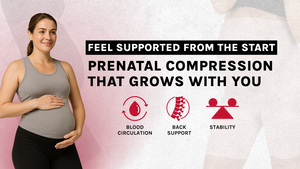Prenatal Support Wear: When to Start and What to Wear
Pregnancy brings physical and hormonal changes that can lead to discomfort and biomechanical strain. Prenatal supportwear has gained popularity as an effective tool to reduce these symptoms by providing gentle compression and stability. Whether you're a first-time mother or preparing for another child, knowing when to start and what to wear makes a significant difference in both comfort and recovery.
When Should You Start Wearing Prenatal Supportwear?
Although every pregnancy is different, many women begin wearing early maternity wear around the end of the first trimester (12–16 weeks). However, you might benefit earlier if you experience bloating, lower back pain, or pelvic instability. A study by Everform Wear (n.d.) notes that compression garments can aid circulation and reduce early pregnancy discomforts such as dizziness and fatigue caused by hormonal changes.
Some women also use pregnancy compression from the first trimester to help with pre-existing conditions like pelvic girdle pain or varicose veins (Motif Medical, n.d.).
What to Wear: Types of Pregnancy Compression Garments
1. Compression Leggings and Shorts
These garments provide support to the abdomen, hips, and lower back. They also help reduce leg swelling and muscle fatigue, especially during long hours of standing or walking (Motif Medical, n.d.).
2. Maternity Support Belts or Belly Bands
These belts offer targeted compression to relieve pressure on the lower back and pelvis. According to The Fix Program (n.d.), pelvic compression helps stabilize the sacroiliac joints, enhancing posture and mobility as the body adapts to pregnancy.
3. Compression Socks
Hormonal and vascular changes during pregnancy often lead to swelling in the lower legs and ankles. Compression socks improve venous return and can prevent varicose veins (Pumps for Mom, n.d.).
Benefits of Prenatal Supportwear
-
Reduces Back and Pelvic Pain
Compression wear supports the musculoskeletal system and can alleviate back pain and pelvic girdle discomfort (The Fix Program, n.d.). -
Improves Circulation and Reduces Swelling
Swelling (edema) is common in pregnancy, especially in the third trimester. Compression garments help manage this by promoting healthy blood flow (Everform Wear, n.d.). -
Supports Better Posture and Stability
As the baby grows, your center of gravity shifts. Supportwear can help you maintain posture and reduce the risk of falls or fatigue (Aeroflow Breastpumps, n.d.). -
Enhanced Comfort During Daily Activities
Everyday tasks can become physically demanding. Wearing prenatal compression makes it easier to walk, stand, or even sleep comfortably (Motif Medical, n.d.).
Choosing the Right Supportwear
When selecting maternity compression, consider:
-
Fit: Ensure a snug but not overly tight fit that accommodates growth.
-
Fabric: Opt for breathable, stretchable materials.
-
Function: Choose based on your needs—whether it’s abdominal support, pelvic compression, or leg circulation.
Conclusion
Prenatal supportwear is a practical and science-backed solution for managing the physical challenges of pregnancy. Starting as early as the first trimester and choosing the right type of compression can significantly improve comfort, mobility, and overall well-being during your pregnancy journey.
References (APA Format)
-
Aeroflow Breastpumps. (n.d.). Postpartum compression vs. postpartum shapewear. Retrieved from https://aeroflowbreastpumps.com/blog/postpartum-compression-shapewear
-
Everform Wear. (n.d.). Benefits of compression wear for pregnancy, postpartum and prolapse. Retrieved from https://everformwear.com.au/a/blog/benefits-of-compression-wear-for-pregnancy-postpartum-and-prolapse
-
Motif Medical. (n.d.). The top benefits of maternity compression wear. Retrieved from https://motifmedical.com/blog/the-top-benefits-of-maternity-compression-wear
-
Pumps for Mom. (n.d.). The ultimate guide to maternity compression. Retrieved from https://pumpsformom.com/compression/the-ultimate-guide-to-maternity-compression
-
The Fix Program. (n.d.). Pelvic compression wear in pregnancy. Retrieved from https://www.fixprogram.com/blog/post/Pelvic-compression-wear-in-pregnancy

